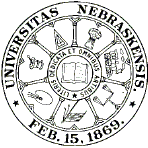
University Studies (University of Nebraska) (1888–1984)
Date of this Version
12-1968
Citation
University of Nebraska Studies: New Series no. 38
Abstract
Juniper has been used since early pioneer days in the protective tree plantings established on the windswept Great Plains. More recently juniper has been used as a basic component of the shelter belt plantings which, by the thousands, dot the prairies of the Great Plains from Texas to Canada. Research to improve the quality of Plains tree planting materials, including Juniperus) is proposed or is now in progress.
In the fall of 1965, 72 native stands of Juniperus were sampled throughout the Missouri River Basin-an area encompassing most of the Central and Northern Great Plains. The purpose was to determine the occurrence and extent of variation in this Juniperus population and to clarify some of the interrelationships between Juniperus scopulorum Sarg. and J. virginiana L., thus establishing a sounder foundation upon which to begin improvement of the planting stock with respect to characteristics desirable in Plains forestry.
The study was based on a taxonomic evaluation of 38 gross morphological, foliage, cone and seed, and infrared characters of 675 trees. Separate analyses involved 675 ovulate and staminate trees with 16 characters, 343 ovulate trees with 24 characters, and 142 ovulate trees with 38 characters in common.
Frequency distributions of character values, correlation coefficients of all possible character combinations, hybrid indices and percent germ plasm distributions were determined to characterize the population. IBM 7040 and 360 electronic computers were utilized as an aid in the analysis.
Analyses suggested the Juniperus population throughout the Missouri River Basin to be of hybrid derivation with neither parental type being found. A strong tendency toward bimodality within the population was demonstrated, however, indicating the presence of two different species-]. scopulorum and J. virginiana. The analyses demonstrated an introgressive trend between southeast and northwest over the Basin from the reported range of J. virginiana into that of J. scopulorum.


Comments
Published by The University at Lincoln